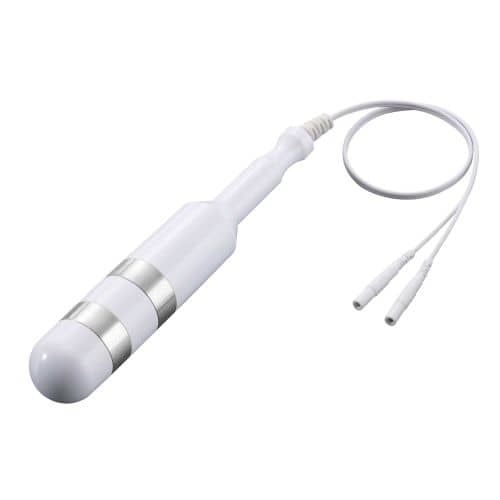
Electrical Muscle Stimulation (EMS) is a rejuvenating technology that uses gentle electrical impulses to stimulate involuntary muscle contractions in your pelvic floor. This creates the same muscle toning action of Kegel squeezing exercises, but is much easier as you never have to worry that you’re not doing it correctly.
In most EMS devices, muscles are stimulated by (tampon sized) probe. The probe delivers a very small electrical charge directly to your muscles to make them painlessly contract – similar to the toning pads you might have seen for abdominal exercisers like Slendertone.
The electrical charge is completely adjustable and builds up from a barely perceivable sensation to whatever level you feel comfortable at. EMS devices can be used before you sleep, whilst you watch TV, or even as you work from home at your desk.
EMS offers the fastest way to increase the firmness, tightness, and strength of your pelvic muscles – for bladder control, sexual function, and overall core stability. For most women, just a few weeks of daily use (for 15-20 minutes) will deliver noticeable positive results. Once your desired level of tone has been achieved, you can maintain it with just 20 minutes use per week.
How an EMS Device Makes Kegels Easier
Takes the Mental Load Off: One of the biggest barriers to doing daily Kegels is finding the time (and inclination) to focus your mind entirely on doing the exercises, which can become somewhat boring and repetitive to do. With an EMS device, you don’t have to worry about focusing your mind on following exercise instructions or actively engaging your pelvic floor muscles. The device does the work for you, meaning you can relax with a book, film or even folding your laundry whilst your Kegels are being toned up.
Ensures Proper Muscle Activation: Many people aren’t sure if they’re doing Kegels correctly, which can limit the effectiveness of the exercises. The EMS device eliminates this uncertainty. By delivering targeted electrical pulses, it ensures that the correct muscles are activated, giving you the same benefits as a traditional Kegel, without the guesswork.
Customizable Intensity Levels: EMS devices are designed to be gentle and customizable. You can adjust the intensity of the electrical pulses to suit your comfort level, making it easier to gradually build strength without overexerting your pelvic muscles. Whether you’re just starting out or you’ve been practicing Kegels for a while, the device can adapt to your needs.
Effective for Those Who Struggle with Manual Kegels: For some people, particularly those starting from the point of having very weak pelvic floor muscles, performing manual Kegels can be difficult or frustrating. An EMS device can help bridge that gap by doing the work for you until your muscles are strong enough to engage on their own. This makes EMS especially beneficial for postpartum recovery or after surgery when the pelvic floor might be particularly weak.
How to Use an EMS Device for Kegels
Using an EMS device is simple and straightforward:
Set aside a few minutes a day: Most EMS devices come with recommended use times, often around 20-30 minutes a session.
Adjust the intensity: Start on a lower setting and gradually increase the intensity as your muscles become stronger.
Relax: Let the device stimulate your pelvic muscles while you go about your day, whether you’re reading, watching TV, or working. You don’t need to actively engage your muscles—just let the device do its job.
By incorporating an EMS device into your routine, you can get all the benefits of regular Kegel exercises without the hassle of remembering or manually contracting your muscles. In our view, investing in a decent EMS device may be the best investment you ever make in your sexual and reproductive health. To read our recommendations for the best appliances currently available to buy, read our Product Reviews here.
Tags:
Kegel; Kegel exercises; pelvic floor exercises; pelvic wall exercises; pelvic floor therapy; ben wa balls; pelvic floor trainers; vaginal floor; non-surgical vaginal rejuvenation; vaginal toning; pelvic floor weakness, Electrical Muscle Stimulation (EMS); EMS